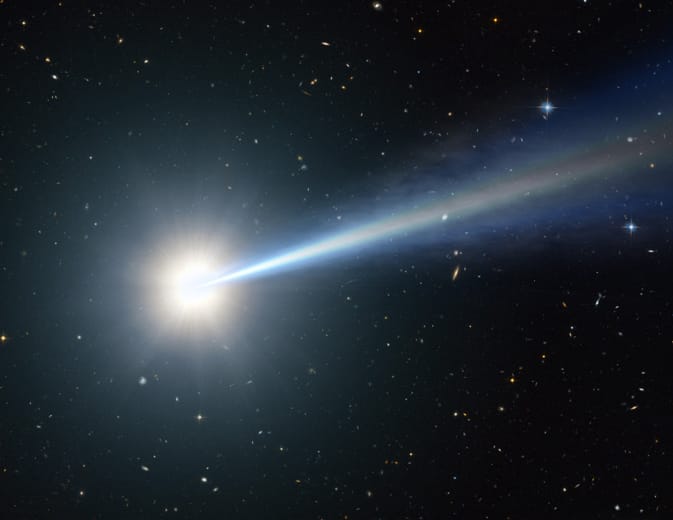Astronomers have detected two big, unexplained objects erupting from the Universe’s brightest black hole.
The supermassive black hole 3C 273 was discovered in a 1959 survey of cosmic radio-wave sources is a quasar – short for “quasi-stellar object,” because the light emitted by these giants is bright enough to be mistaken for starlight.

While black holes themselves do not emit light, rather they are surrounded by massive swirls of gas known as accretion discs. As gas falls into the black hole at near-light speed, friction heats the disc, causing it to blaze with radiation, which is typically detected as radio waves.
Related: JWST will uncover the brightest Quasar in the early Universe
What Was The First Quasar To Be Discovered?
The first quasar to be discovered was 3C 273. It’s also the brightest, shining more than 4 trillion times brighter than Earth’s Sun despite being more than 2.4 billion light-years away.
Scientists have spent decades researching the flaming black hole nucleus, but analyzing the surrounding galaxy that hosts it has been nearly impossible due to the quasar’s brightness. Ironically, quasars’ extraordinary brightness has kept scientists largely in the dark about how they affect their host galaxies.
Can We Observe The Quasars?
A team of astronomers used the Atacama Large Millimeter/submillimeter Array (ALMA) radio telescope in Chile to calibrate it so that it could distinguish the radiant glow of quasar 3C 273 from the light generated by its host galaxy.
They were left with only the quasar’s galaxy’s radio waves, which revealed two gigantic and enigmatic radio structures that had never been seen before.
One structure appears to be a massive smear of radio light that envelops the entire galaxy and extends thousands of light-years to the southwest. This radio fog collides with the second structure, a massive energy jet known as an astrophysical jet that reaches for tens of thousands of light-years as well.
Why Are Quasars Strange?
Astrophysical jets are a mystery to scientists. They don’t know how or why they form. They do know that jets are prevalent near quasars and other supermassive black holes, and that they are most likely caused by interactions between the black hole and its dusty accretion disc. Ionized (electrically charged) matter is used to make jets, which travel at near-light speed.
The radiation emitted by these jets can look brighter or darker depending on the radio frequency at which it is observed; nevertheless, the huge radio structure orbiting galaxy 3C 273 had a consistent brightness regardless of frequency. This shows that the two radio structures are formed by independent, unconnected events, according to the researchers.
Related: Discover The Undiscover: Webb’s Quest For Primeval Black Holes
What Is The Secret Behind The Huge Radio Fog?
After putting numerous possibilities to the test, the researchers came to the conclusion that the huge radio fog seen around the galaxy is caused by star-forming hydrogen gas being ionized directly by the quasar.
According to the researchers, this is the first time ionized gas has been discovered reaching tens of thousands of light-years around a supermassive black hole.
This finding sheds light on a long-standing astronomical puzzle: can a quasar ionize enough gas in its host galaxy to prevent new stars from forming? To get an answer, the researchers compared the estimated gas mass of the galaxy to that of other galaxies of similar type and size.
What Did The Researchers Find?
They discovered that, while the quasar had ionized a massive amount of gas, rendering it unusable for formation of star. Star formation in the galaxy as a whole had not been repressed. This shows that galaxies with radiation-belching quasars at their centers can nonetheless be thriving and growing.
In a statement, principal study author Shinya Komugi, an associate professor at Kogakuin University in Tokyo, said, “This discovery opens a new way to studying difficulties previously solved utilizing observations by optical light.”
“We hope to understand how a galaxy evolves through its interaction with the core nucleus by applying the same technique to other quasars.”
